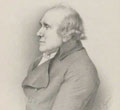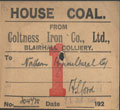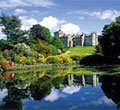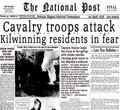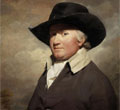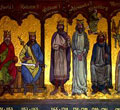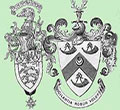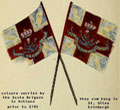Hunters Hall of Fame
John Hunter, F.R.S., anatomist and surgeon
John Hunter, (1728-1793), anatomist and surgeon, born on 13 Feb. 1728 at Long Calderwood, in the parish of East Kilbride, Lanarkshire, was the youngest of ten children. His father, John Hunter (d. 1741, aged 78), was descended from an old Ayrshire family, Hunter of Hunterston (assumed ~ not proven), and was a man of intelligence, integrity, and anxious temperament. His mother, Agnes Paul, daughter of the treasurer of the city of Glasgow, was an excellent and handsome woman.
As a boy Hunter showed little taste for books,
loved country sports, and being allowed to neglect school never overcame the defects of his education. When about seventeen he went to stay in Glasgow with his sister, Mrs. Buchanan, whose husband, a cabinet-maker, was in difficulties. Hunter helped him for some time in his trade, and acquired much mechanical skill.
In his twentieth year he visited his brother William (1718-1783) in London, with a view to assisting in his
dissecting room. He travelled on horseback in September 1748, and was set to work on a dissection of the arm-muscles. Succeeding beyond expectation, he was able to superintend pupils in the second season.
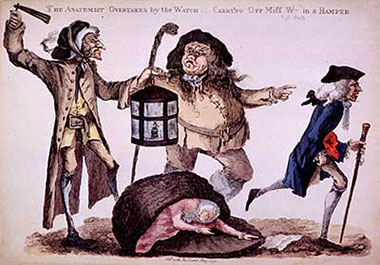
satirical cartoon, at that time, showing John Hunter
He was very popular with the "resurrection-men" who were then essential to the anatomist, was fond of lively company and of the theatre, and was familiarly known as 'Jack Hunter.'
In the summer of 1749-50 his brother obtained permission for him to attend Chelsea Hospital under William Cheselden.
In 1751 he became a pupil of Pott at St. Bartholomew's.
In 1753 he was appointed one of the 'masters of anatomy' of the Surgeons' Corporation.
In 1754 he entered as a surgeon's pupil at St. George's Hospital, where he was house-surgeon for some months in 1756.
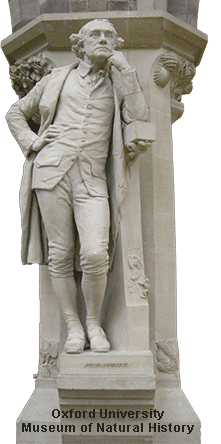 On 5 June 1755 he was matriculated as a commoner of St. Mary Hall, Oxford. The last entry for battels against his name in the buttery accounts is dated 25 July 1755, but his name was kept on the books till 10 Dec. 1756.
On 5 June 1755 he was matriculated as a commoner of St. Mary Hall, Oxford. The last entry for battels against his name in the buttery accounts is dated 25 July 1755, but his name was kept on the books till 10 Dec. 1756.
In later years Hunter told Sir Anthony Carlisle, "They wanted to make an old woman of me, or that I should stuff Latin and Greek at the university; but," he added, significantly pressing his thumbnail on the table, "these schemes I cracked like so many vermin as they came before me."
Both Home and Ottley state that Hunter began to assist his brother in lecturing in 1754. In the "European Magazine" for October 1782 (ii. 247) it is stated, on the other hand, apparently on John Hunter's authority, that his brother wished to take him into partnership with him, and in 1758 declared him fully competent, but that he declined on account of his aversion to public speaking and extreme diffidence. Assisting in lecturing did not, however, involve partnership, and the two statements are not incompatible. There is evidence that during this period John traced the descent of the testis in the foetus; made discoveries as to the nature of the placental circulation; investigated the nasal and olfactory nerves; tested the absorbing powers of veins; studied the nature of pus, and did a great deal, in concert with his brother, to determine the course and functions of the lymphatic system. Although William often acknowledged that he was in certain points simply his brother's interpreter, John thought his acknowledgments insufficient. Weakness of health, after an attack of inflammation of the lungs in 1759, induced him to leave his brother and accept in October 1760 a staff-surgeoncy in Hodgson and Keppel's expedition to Belleisle, which sailed in 1761.
While off Belleisle he was studying the conditions of the coagulation of the blood (Treatise on the Blood, p. 21).
In 1762 he served with the British army in Portugal, and acquired an extensive knowledge of gunshot wounds and inflammation, pursuing at the same time his study of human anatomy and of the physiology of hibernating animals.
Returning to London on half-pay in 1763, Hunter started in practice as a surgeon in Golden Square, and soon formed a private class for anatomy and operative surgery; but owing to his ineffective delivery and exposition, his pupils never numbered more than twenty. He also took resident pupils. His studies in comparative and human anatomy and in surgery he continued with indefatigable zeal. He obtained the refusal of all animals dying in the Tower menagerie and other collections, and in some cases bought rare animals, which he allowed to be exhibited on condition that he received the carcases at death. Sir Everard Home stated that as soon as he accumulated ten guineas by fees, Hunter always
made some addition to his collection. On one occasion he borrowed five guineas from G. Nicol, the king's bookseller, to buy a dying tiger (OTTLEY, p. 29).
Every hour he could snatch from practice or sleep was devoted to dissection, experiment, and reflection. In 1764 he bought two acres of land at Earl's Court, Kensington, and built a plain house on it, which he afterwards greatly enlarged.
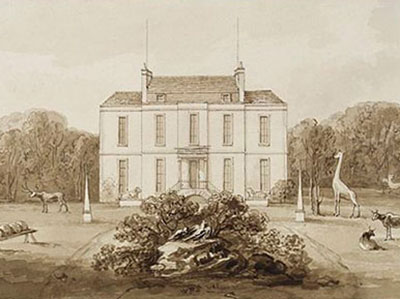
impression of John's house at that time
Here he had all kinds of conveniences for dissection, maceration, &c., as well as cages for living animals. He had a pond ornamented with skulls in the garden, where he made experiments on the artificial formation of pearls in oysters. He was very fond of bees, having several hives in his conservatory, but he was fondest of the fiercer quadrupeds.Once he was thrown down by a little bull which Queen Charlotte had given him. On another occasion two leopards broke loose, but, though unarmed, he mastered them both. In 1766 he made his first communication to the Royal Society, an anatomical description of a siren from South Carolina, and was elected F.R.S. on 5 Feb. 1767 (earlier than his elder brother William). In 1767 he ruptured his tendon Achillis by an accident, and his study of his own case and of the mode of repair of ruptured tendons led to the present improved practice of cutting through tendons under the skin for the relief of distorted and contracted joints.
In 1767 he became a member of the Surgeons' Corporation, and in the following year was a candidate for the surgeoncy to St. George's Hospital, in succession to Gataker. His brother supported him, and he was elected on 9 Dec. by 114 votes to 42 given for D. Bayford. His practice increased, and in 1768 he removed to the large house in Jermyn Street which his brother had vacated. Here he took house-pupils, who were bound to him for five years, at a premium of five hundred guineas.
Among them was Edward Jenner, to whom Hunter became much attached, and whom in 1775 he begged to join him in lecturing. Many of his interesting letters to Jenner are given in Baron's "Life of Jenner," and others are in Ottley's "Life of Hunter." In May 1771 Hunter published the first part
of his 'Treatise on the Human Teeth,' and in July of the same year he married Miss Anne Home [see Anne Hunter]. Though they got on well together, her taste for fashionable society sometimes irritated Hunter, who once, upon finding his drawing-room full, said that he had not been informed of 'this kick-up,' and requested the guests to disperse.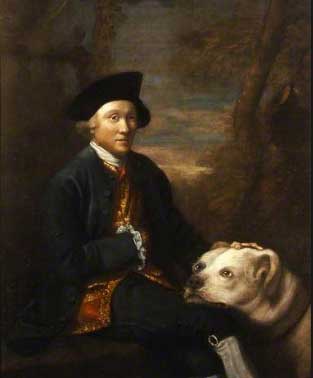
John painted around 1770 by his brother-in-law Robert Home.
The dog is one of John's wolf-dog hybrids.
In June 1772 he contributed to the Royal Society his celebrated paper 'On the Digestion of the Stomach after Death,' the first of many important papers.In the autumn of 1772
his brother-in-law, Everard Home, became his pupil, and describes the museum as at this time filling all the best rooms in his house. Travellers often sent him rarities, and he also bought anything curious bearing on his subjects. Until 1774, however, his income did not reach £1,000 a year. In 1773 he began to lecture on the theory and practice of surgery, at first to his pupils and a few friends admitted gratuitously, but afterwards on payment of a fee of four guineas. In these lectures Hunter may be said to have first introduced into this country the idea of "principles' of surgery, including a rational explanation of processes of repair and a scientific basis for operations.
He never overcame his difficulty in lecturing, and at the beginning of each course he always composed himself by a draught of laudanum. He read his lectures on alternate evenings from October to April from seven to eight o'clock. His class was usually comparatively small, seldom exceeding thirty, but it included such men as Astley Cooper, Cline, Abernethy, Anthony Carlisle, Chevalier, and Macartney. In 1773 he had his first attack of angina pectoris, from which he afterwards suffered very severely when mentally distressed. In 1775 he engaged a young artist named William Bell to reside with him, make anatomical preparations and drawings, and superintend his museum. Bell stayed with him till 1789, when he became an assistant-surgeon to the East India Company, and died in 1792.
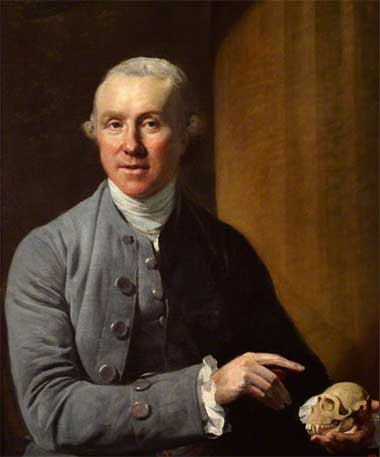
In January 1776 Hunter was appointed surgeon extraordinary to George III, and in the same year, being interested in the Humane Society's work, drew up for the Royal Society his 'Proposals for the Recovery of People apparently Drowned.' In the same year he delivered before the Royal Society the first of his six "Croonian Lectures" on muscular motion, 1776-82, which were published posthumously in his works. In 1777 Hunter suffered severely from vertigo. He had to leave London and visit Bath in the autumn, when he met Jenner, who was surprised at his altered appearance, and diagnosed that he had an organic affection of the heart.
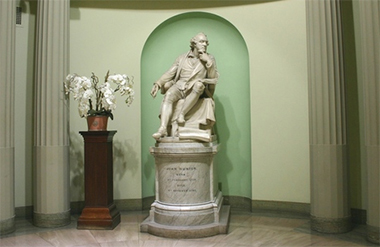
John's statue at the Royal College of Surgeons
In January 1780 Hunter read a paper before the Royal Society on the structure of the human placenta, in which he laid exclusive claim to certain discoveries regarding the utero-placental circulation which his brother had claimed in his lectures and in his work on the uterus. William Hunter protested in a letter to the society (3 Feb. 1780) that the discovery was well known to be his, and had never been previously contested.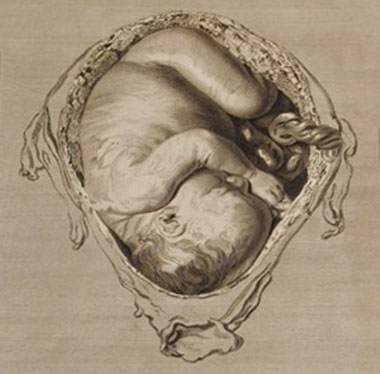
John Hunter in reply asserted that he had made the discoveries in dissecting a preparation in May 1754, with Dr. Mackenzie, an assistant of Smellie, and that he had afterwards communicated them to his brother, who at first pooh-poohed and
afterwards adopted them. The society decided not to print John Hunter's paper or the correspondence. His account as to facts may be safely accepted. There is no doubt that in William's study of the subject this dissection figured only as one incident, or that he regarded discoveries made in his dissecting room as his property. An estrangement followed between the brothers, which was barely healed on the deathbed of the elder.
In 1781 Hunter was called as a scientific witness by the defence in the trial of Captain Donellan at Warwick for the alleged poisoning of his brother-in-law, Sir Theodosius Boughton, with laurel-water, and in cross-examination became hesitating and confused, and was contemptuously mentioned by the judge, Francis Buller. His evidence had really been given with proper scientific caution, and stands the test of later knowledge.
In 1783 he acquired the most expensive specimen in his museum, the skeleton of O'Brien or O'Byrne, the Irish giant,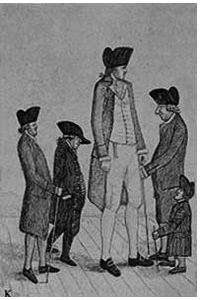 seven feet seven inches high, said to have cost him £500. The giant had by his will tried to prevent Hunter from obtaining his skeleton, by ordering his coffin to be securely sunk in deep water; but Hunter bribed the undertaker heavily, and the body was stolen while on its way to the sea, was taken by Hunter to Earl's Court in his own carriage, and was promptly skeletonised. In this year he was elected a member of the Royal Society of Medicine and the Royal Academy of Surgery of Paris, and he took part in forming a Society for the Improvement of Medical and Chirurgical Knowledge, which lasted about twenty years, and published three volumes of "Transactions". In view of the expiration of his lease in Jermyn Street in the end of 1783, he bought the lease for twenty-four years of two houses, one on the east side of Leicester Square (No. 28), and the other in Castle Street, with the intervening ground. During the next two or three years he spent £3,000 in building on the vacant ground a large museum, with lecture-rooms below (now used as a violin maker's factory), carrying on his anatomical work in the Castle Street house, and living in Leicester Square. His collections, which had cost him £10,000, were removed into the museum in April 1785, under the care of Everard Home, Bell, and Andre, another assistant.
seven feet seven inches high, said to have cost him £500. The giant had by his will tried to prevent Hunter from obtaining his skeleton, by ordering his coffin to be securely sunk in deep water; but Hunter bribed the undertaker heavily, and the body was stolen while on its way to the sea, was taken by Hunter to Earl's Court in his own carriage, and was promptly skeletonised. In this year he was elected a member of the Royal Society of Medicine and the Royal Academy of Surgery of Paris, and he took part in forming a Society for the Improvement of Medical and Chirurgical Knowledge, which lasted about twenty years, and published three volumes of "Transactions". In view of the expiration of his lease in Jermyn Street in the end of 1783, he bought the lease for twenty-four years of two houses, one on the east side of Leicester Square (No. 28), and the other in Castle Street, with the intervening ground. During the next two or three years he spent £3,000 in building on the vacant ground a large museum, with lecture-rooms below (now used as a violin maker's factory), carrying on his anatomical work in the Castle Street house, and living in Leicester Square. His collections, which had cost him £10,000, were removed into the museum in April 1785, under the care of Everard Home, Bell, and Andre, another assistant.
In this year he made the experiments on the mode of growth of deer's antlers which resulted in his discovery of the establishment of collateral circulation by anastomosing
branches of arteries. The discovery led him in December to tie the femoral artery of a patient suffering from popliteal aneurysm, trusting to
the development of the collateral circulation. His procedure was justified by the patient's recovery in six weeks (see HOME, Trans. Society for Improvement of Med. and Chir. Knowledge, i. 138). Operations of a similar kind have since saved very many lives. In 1786 he published his "Treatise on the Venereal Disease," after many years' study, and also his "Observations on certain parts of the Animal Economy" both being printed in his own house. In the same year, on the death of Middleton, he was appointed deputy surgeon-general to the army, and in 1790, on the death of Adair, surgeon-general and inspector-general of hospitals. In 1787 he received the Copley medal from the Royal Society for his discoveries in natural history.
The death of Pott in December 1788 left Hunter the undisputed head of the surgical profession. Soon afterwards he secured the services of Home as assistant-surgeon at St. George's, and in 1792 Home undertook the delivery of Hunter's surgical lectures with the aid of his manuscripts. Hunter now devoted much of his spare time to completing his great work on 'The Blood. Inflammation, and Gunshot Wounds,' which he did not live to publish.
Early in 1792, on the resignation of Charles Hawkins, Thomas Keate, then assistant to John Gunning, the senior surgeon at St. George's, was chosen surgeon by a considerable majority, in opposition to Home, who was Hunter's candidate. At the conclusion of the acrimonious contest Hunter
announced his intention of no longer dividing with the other surgeons the fees he received for pupils, on the ground that they neglected to instruct them properly. The surgeons denied his right to take this action, and the subscribers to the hospital supported them. A letter addressed to the subscribers by Hunter on 28 Feb. 1793 (see Lancet, 3 July 1886) details the efforts he had made to induce his colleagues to improve their teaching. The other surgeons, in concert with a committee, drew up rules for the admission and regulation of pupils, without consulting Hunter.
One rule forbade the entry of pupils without previous medical instruction.
Two young Scotchmen ignorant of the rule came up in the autumn and appealed to Hunter, who undertook to press for their admission at the next board meeting on 16 Oct. 1793.
On the morning of that day he expressed his anxiety lest a dispute should occur, being convinced that the excitement would be fatal to him. His life, he used to say, was "in the hands of any rascal who chose to annoy and tease him." At the meeting, while Hunter was speaking in favour of his request, a colleague (probably Gunning) flatly contradicted one of his statements.
Hunter immediately ceased speaking and retired into an adjoining room, where he almost immediately fell dead in the arms of Dr. Robertson, physician to St. George's. Autopsy revealed that the mitral valves and coronary arteries were ossified, and that the heart was otherwise diseased.
He was buried on 22 Oct. 1793 in the vaults of St. Martin-in-the-Fields.
On 28 March 1859 his remains, having been identified by  Francis Trevelyan Buckland, were removed, at the cost of the Royal College of Surgeons of England, to Abbot Islip's Chapel, on the north side of the nave of Westminster Abbey. In 1877 a memorial window to Hunter was placed in the north transept of Kensington Parish Church by public subscription. His
widow survived till 1821. Of his four children, two survived him: John, who became an officer in the army, and Agnes, who married Captain James Campbell, eldest son of Sir James Campbell; neither left issue.
Francis Trevelyan Buckland, were removed, at the cost of the Royal College of Surgeons of England, to Abbot Islip's Chapel, on the north side of the nave of Westminster Abbey. In 1877 a memorial window to Hunter was placed in the north transept of Kensington Parish Church by public subscription. His
widow survived till 1821. Of his four children, two survived him: John, who became an officer in the army, and Agnes, who married Captain James Campbell, eldest son of Sir James Campbell; neither left issue.
In person Hunter was of middle height, vigorous, and robust, with high shoulders and rather short neck. His features were strongly marked, with prominent eyebrows, pyramidal forehead, and eyes of light blue or grey. His hair in youth was a reddish yellow, and in later years white. The fine
portrait by Sir Joshua Reynolds (painted in May 1785) in the possession of the Royal College of Surgeons was a happy and sudden inspiration, due to Hunter's falling into a reverie. 
A copy by Jackson is in the National Portrait Gallery, and another is in St. Mary Hall, Oxford. Sharp's engraving from it (1788) is one of his best works.
(Unfortunately Reynolds tried a new painting medium which ended up darkening over time, losing much of the selected
background detail, see inset comparison.
An interesting article discussing the background details can be found on another website.
Hunter often rose at five or six to dissect, breakfasted at nine, saw patients till twelve, and visited his hospital and outdoor patients till four. He was most punctual and orderly in his visits, leaving a duplicate of his visiting-book at home, so that he could be found at any time. He dined at four. For many years he drank no wine, and sat but a short time at table, except when he had company. He slept for an hour after dinner, then read or prepared his lectures, made experiments, and dictated the results of his dissections. He was often left at midnight, with his lamp freshly trimmed, still at work. He wrote his first thoughts and memorandums on odd scraps of paper. These were copied and arranged, and formed many folio volumes of manuscript. Hunter would often have his manuscripts rewritten many times, making during the process endless corrections and transpositions.
In manners Hunter was impatient, blunt, and unceremonious, often rude and overbearing, but he was candid and unreserved to a fault. He read comparatively little, and could never adequately expound the information already accessible on any subject. Most of what he knew he had acquired himself, and he attached perhaps undue importance to personal investigation. Few men have ever done so much with so little book-learning. His detachment from books, combined with his patient search for facts, gave him a vital grip of subjects most needing to be studied in the concrete. His opinions were always in process of improvement, and he never clung to former opinions through conservatism. Yet he was a tory in politics, and 'wished all the rascals who were dissatisfied with their country would be good enough to leave it.' He would rather have seen his museum on fire than show it to a democrat. He was usually taciturn, but when he spoke his words were well chosen, forcible, and pointed, often broadly or coarsely humorous. But although he could never spell well or write grammatically, and his writings were carefully revised by others before they were printed, they preserve his ruggedness of style.
He occasionally became confused in his lectures, and,would advise his hearers not to take down a passage. 'My mind is like a beehive,' he said to Abernethy, a simile which struck the latter as very correct, for in the midst of buzz and apparent confusion there was great order, regularity, and abundant store of food, which had been collected by incessant industry (Hunterian Oration, 1819). His power of sustained and persevering industry was enormous. Clift describes him as 'standing for hours, motionless as a statue, except that, with a pair of forceps in each hand, he was picking asunder the connecting fibres of some structure he was studying,' and he was equally capable of absorption for hours in thought. He felt that although he was a pigmy in knowledge, he was a giant compared with his contemporaries. He only valued money for the aid that it gave to his researches. He never took fees from curates, authors, or artists. His income, which first reached £1,000 in 1774, was £5,000 for some years later, and £6,000 before his death. He often sent valuable patients to young men starting in practice, and gave promising men tickets for his lectures.
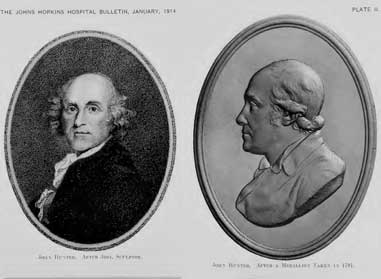
As an investigator, original thinker, and stimulator of thought, Hunter stands at the head of British surgeons. His originality was equally evidenced in the devising of crucial experiments and in his prevision of truths which he could not have learned from others or by direct observation.
Such truths are his belief that the blood is alive in the same sense as other parts of the body; and that higher animals in passing from the embryo to the complete form go through a series of changes, in each of which it resembles the adult form of some lower creature.
He thought that occasional distinctness of sex in hermaphrodite animals might account for the origin of distinct sexes (compare DARWIN, Descent of Man).
His strong belief that life was a principle of force separate from and anterior to organisation was never clearly and consistently put forward; but it was raised by his pupils into a dogma, especially by Abernethy, and was an important subject of controversy before modern chemical and physical discoveries had given precision to physiological ideas. One of Hunter's most distinctive merits was his grasp of living beings in one view, as one science. He was an all-round naturalist with an object, that of explaining life and organisation, and discovering principles of surgery.
Hunter's 'Treatise on the Blood, Inflammation, and Gunshot Wounds' is his most important work; it is a compound of physiology, pathology, and surgery, and, while defective in regarding the red corpuscles as the least important part of the blood, is full of original observations and remarks.
His account of inflammation necessarily loses value, since modern observations have revealed its nature, but it marked a great advance in knowledge, and for many years it
stimulated the progress of surgery, and some of his views have been in recent times found to be truer than others which supplanted them.
His most notable surgical advance was in the tying of the artery above the seat of disease in aneurysm. But the general influence of his teaching and method of study was even more important. Sir James Paget and many others term him "the founder of scientific surgery" as having first studied and
directed attention to the processes of disease and repair on which the practice of surgery is based, and having brought to this study a large knowledge of physiology.
He was a cautious rather than a brilliant operator, and never used the knife when he could avoid it, holding that 'to perform an operation is to mutilate a patient we cannot cure, and so an acknowledgment of the imperfection of our art.' He was very cautious in deductions from physiology, and 'in many of his writings on surgical practice there is hardly a sign that he was a great physiologist' (PAGET).
In comparative anatomy his work was extensive and of permanent value, yet not so valuable as Cuvier's, for he studied the subject in order to obtain knowledge of human physiology and pathology, and not for itself. But his papers as now published, and his museum show that ‘Hunter had collected materials for a work which needed but the finishing touches to have made it one of the greatest, most durable, and valuable contributions ever made by any one man to the advancement of the science of comparative anatomy’ (Professor W. H. Flower, Introductory Lecture, 14 Feb. 1870). His observations and experiments on vegetable life were numerous and important.
Hunter's ‘Observations and Reflections on Geology,' not published till 1859, as an introduction to the College of Surgeons' ‘Catalogue of Fossils,' and his posthumous paper ‘On Fossil Bones' (Phil. Trans. 1794, lxxxiv. 407) indicate a perception of the changes undergone by fossils and of their general scientific value, which was far in advance of his time. He recognised water as the chief agent in producing changes, but showed that the popular notion about the deluge was erroneous. He inferred that there had been repeated changes in the level of land, lasting many thousand centuries, and important climatic variations, and he made numerous other correct inferences in physical geology. The ‘Observations' were at first intended for the Royal Society; but objections were made by a geological friend to his use of language which implied that the earth was more than six thousand years old, and he consequently did not send in the paper to the society.
Hunter's works, and especially his posthumous papers, contain numerous psychological remarks, exhibiting much originality and shrewdness, without evidence of systematic study.
Hunter designed his museum to illustrate the entire phenomena of life in all organisms, in health and disease. Its essential plan was physiological. It included, besides wet preparations which enabled all structures with similar functions to be compared, dried and osteological preparations of all kinds, monsters and malformations, fossils, plants and parts of plants, and all manner of products of diseased action. There were also many drawings, oil-paintings, and casts illustrating disease. He had apparently intended to give in a catalogue an account of his observations in each department. On matters relating to dissection, preservation, and embalming, his hints and directions are of the greatest value.
An account is given under Home, Sir Everard, and Clift, William, of the destruction of Hunter's manuscripts by Home after he had utilised them for his own purposes for many years. Clift's transcripts, which are in the library of the Royal College of Surgeons of England, were published by Sir R. Owen in ‘Essays and Observations,’ 1861 (see below).
By his will Hunter left his paternal estate, which Dr. Baillie had made over to him, to his son, and directed Earl's Court to be sold, and the proceeds, after payment of debts, to be divided between his widow and two children. His museum was to be first offered to the British government on reasonable terms, and if refused was to be sold to some foreign state, or in one lot by auction. In the condition of the national finances in 1793 Mr. Pitt showed no eagerness to buy it. To maintain his family while negotiations were in progress, his furniture, library, crystals, paintings, and objects of vertu were sold. Sir Joseph Banks, president of the Royal Society, did not in 1796 consider Hunter's museum ‘an object of importance to the general study of natural history.' In 1799 a committee of the House of Commons recommended the purchase of Hunter's collection for £15,000, having heard evidence that it was worth much more. This sum was voted, and the collection was offered by government to the Royal College of Physicians. On their refusal, it was offered to and accepted by the Royal College of Surgeons in 1800, under a board of trustees, on condition that a proper catalogue should be made, a conservator appointed, and that twenty-four lectures on comparative anatomy should be delivered annually at the college. The erection of a suitable building to contain it was aided by further government grants of £15,000 and £12,500, and the museum was opened in 1813, in which year Dr. Baillie and Sir Everard Home arranged for the delivery of an annual Hunterian oration on Hunter's birthday. In 1819 the Hunterian Society was founded in connection with the College of Surgeons.
Besides his papers in ‘Medical Commentaries,' the ‘Philosophical Transactions,' and ‘Transactions of a Society for Improvement of Medical and Chirurgical Knowledge,'of which Ottley gives a complete list, Hunter wrote:
- ‘A Treatise on the Natural History of the Human Teeth,' London, 4to, pt. i., 1771; pt. ii., 1778. On the publication of pt. ii. the two parts bound together were sold as a second edition with a new title-page; 3rd edit., 1803.
- ‘A Treatise on the Venereal Disease,' London, 1st edit., 4to, 1786; 2nd edit., 4to, 1788; 3rd edit., 4to, 1794, with notes by Sir E. Home (this edition was reprinted from the first edition, and contains the errors which Hunter had corrected in the second edition. Home also incorporated remarks of his own in the text undistinguishably, and omitted whole paragraphs or parts of paragraphs); 4th edit., edited by Joseph Adams, 8vo, 1810; 5th edit., by Home, 1809.
- 'Observations on certain parts of the Animal (Economy,' 4to, 1786, including his papers on the fœtal testes, the vesiculæ seminales, and nine papers from the 'Philosophical Transactions,' viz. on the free-martin (hermaphrodite cow), on a hen-pheasant with cockfeathers, on the organ of hearing in fishes, on the air receptacles of birds, on animal heat, on the recovery of the apparently drowned, on the structure of the placenta, on the Gillaroo trout; also a long paper on digestion, the colour of the eye-pigment in various animals, and the nerve of the organ of smell; 2nd edit., revised and enlarged, 1792. The principal addition is Hunter's 'Observations tending to show that the Wolf, Jackal, and Dog are all of the same species.'
- 'A Treatise on the Blood, Inflammation, and Gunshot Wounds,' London, 4to, 1794; with & short account of the author's life by Sir E. Home, 2nd edit., 1812, 2 vols. 8vo; 3rd edit., 2 vols., 1818; 4th edit., 1 vol., 1828.
- 'Directions for Preserving Animals and parts of Animals for Anatomical Investigation,' published by the Royal College of Surgeons in 1809.
- 'The Works of John Hunter' were edited, with notes, by James F. Palmer, 4 vols. 8vo, with a 4to vol. of plates, mostly from the originals, 1835-7; vol. i. included Ottley's 'Life of J.Hunter,'and Hunter's 'Surgical Lectures,' delivered in 1786 and 1787, from the shorthand notes of Mr. Henry Rumsey of Chesham, collated with Parkinson's and other notes; vol. ii. 'The Treatise on the Teeth,' with notes by Thomas Bell' (1792–1880), and that 'On the Venereal Disease,' with notes by G. G. Babington; vol. iii. 'Treatise on the Blood, Inflammation, &c.,' with papers, &c., published in 'Transactions of Society for Improvement of Medical and Chirurgical Knowledge;' vol. iv. 'Observations on certain parts of the Animal (Economy,' with preface and notes by R. Owen; the six 'Croonian Lectures on Muscular Motion,' and his other zoological papers.
- 'Observations and Reflections on Geology. … Intended to serve as an Introduction to the Catalogue of his Collection of Extraneous Fossils,' London, 1859, 4to.
- 'Memoranda on Vegetation,' 1860, 4to.
- 'Essays and Observations on Natural History, Anatomy, Physiology, Psychology, and Geology,' being his posthumous papers on those subjects, copied by William Clift, arranged and revised with notes by Sir R. Owen, together with Owen's `Lectures on the Hunterian Collection of Fossils,' delivered in March 1855, London, 8vo, 2 vols., 1861, with engraving from a bronze medallion of Hunter, executed in 1791. 'Hunterian Reminiscences,' by J. Parkinson, give the substance of Hunter's lectures in 1785. There are numerous translations and American editions of Hunter's works. Among contemporary criticisms of Hunter are: `An Essay on the Bite of a Mad Dog, with Observations on John Hunter's Treatment of the case of Master R——,' by Jesse Foot the elder, 1788; 'Observations on the New Opinions of John Hunter,' &c., by Jesse Foot the elder; and John Thelwall's 'Essay towards a definition of Animal Vitality, in which the Opinions of John Hunter are examined,'Lond.,1793, 4to.

Drawing of John in his final year.
[European Mag. October 1782, pp. 245–7 (Abernethy was told by the editor, Perry, that Hunter supplied materials for this article); Gent. Mag. 1793, ii. 964 (inaccurate); Lives by Sir E. Home (prefixed to Hunter's Treatise on the Blood, &c., 1794), Jesse Foot, 1794, Joseph Adams, 1817, Drewry Ottley, 1835 (the best), and Sir W. Jardine (1836), prefixed to vol. x. of the Naturalist's Library; Baron's Life of Jenner; S. D. Gross's John Hunter and his Pupils (with portrait), Philadelphia, 1881; Buckle's Hist, of Civilisation in England (1869), iii. 428-58; Only an Old Chair, a Tercentenary Tribute by D. R. A. G. M., Edinburgh, 1884; John Hunter at Earl's Court, Kensington, 1764–93, by J. J. Merriman, 1886; Hunterian Orations, especially those of Sir James Paget, 1877, Joseph H. Green, 1847, Sir B. Brodie, 1837, and Thomas Cheralier, 1821; Tom Taylor's Leicester Square, 1874, chap. xiv., with a Sketch of Hunter's Scientific Character and Works by Sir R. Owen; Leslie and Taylor's Life of Sir Joshua Reynolds, ii. 474. See also Lancet, 3 July 1886, 29 Sept. 1888, pp. 642, 643; an Appeal to the Parliament of England on the subject of the late Mr. John Hunter's Museum, London, 1795; Catalogues of the Hunterian Museum; information from Mr. Charles Hawkins, F.R.C.S.]
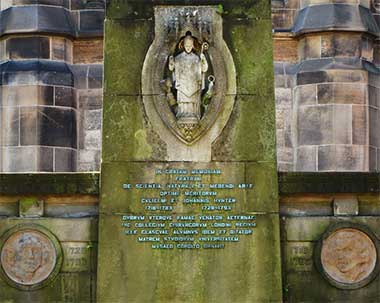
Glasgow University memorial to the brothers.

